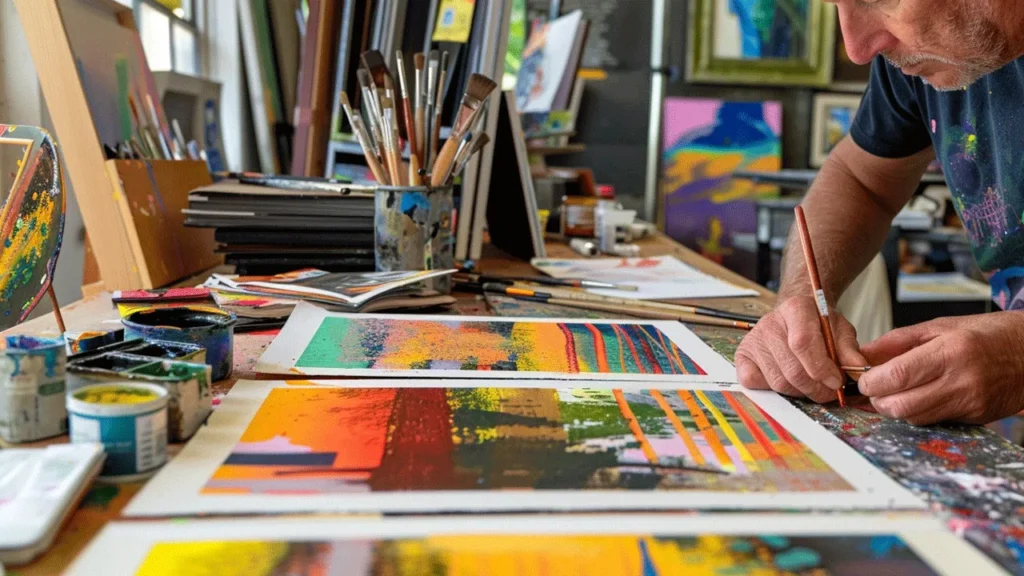Giclée printing has revolutionized the fine art industry by providing artists with a method to create high-quality, archival reproductions of their work. This technique combines advanced printing technology with exceptional materials, producing results that rival original artworks in detail and vibrancy. Here’s everything you need to know about Giclée printing and why it has become the gold standard for fine art reproductions.

What is Giclée Printing?
The term “Giclée” (pronounced “zhee-clay”) originates from the French word “gicler,” meaning “to spray.” It refers to the process of spraying microscopic droplets of pigment-based ink onto paper or canvas. Giclée printing uses advanced inkjet printers with high-resolution capabilities, ensuring extraordinary detail and accuracy.
This method was first developed in the late 1980s by printmaker Jack Duganne and has since become a preferred choice for artists, photographers, and collectors worldwide.
Key Features of Giclée Printing
High Resolution
Giclée printers use resolutions up to 1440 DPI (dots per inch) or higher, creating incredibly sharp and detailed images. This precision ensures the reproduction captures every nuance of the original artwork.
Pigment-Based Inks
Unlike dye-based inks, pigment-based inks used in Giclée printing are more durable and resistant to fading. They can last over 100 years under proper care, making them ideal for archival purposes.
Archival Quality Materials
Giclée prints are produced on acid-free, archival-grade paper or canvas. These materials help preserve the artwork’s vibrancy and integrity over time.
Wide Color Gamut
With the ability to use up to 12 different ink colors, Giclée printing achieves a broader color gamut compared to traditional printing methods. This results in more accurate and vivid reproductions.
Benefits of Giclée Printing for Artists and Collectors
Faithful Reproduction
Giclée printing allows artists to reproduce their work with an incredible level of detail and color fidelity. This makes it an excellent option for selling limited editions or creating portfolio pieces.
Customizable Sizes
Artists can produce prints in various sizes, offering buyers flexibility while maintaining the original artwork’s proportions and integrity.
Accessibility
Giclée printing makes fine art more accessible by allowing collectors to own museum-quality reproductions at a fraction of the cost of an original piece.
Durability
The archival quality of Giclée prints ensures they remain vibrant and intact for decades, making them a valuable investment for collectors.
How to Identify a Giclée Print
To distinguish a Giclée print from other types of reproductions, look for the following characteristics:
- Fine Detail: Giclée prints reproduce even the smallest details of the original artwork, including subtle textures.
- Rich Colors: The wide color gamut ensures a depth and vibrancy unmatched by other methods.
- Archival Materials: Genuine Giclée prints are produced on high-quality, acid-free paper or canvas.
- Printer and Ink Information: Reputable sellers will specify that the print was created using Giclée technology with pigment-based inks.
Applications of Giclée Printing
Fine Art Reproductions
Giclée printing is a popular choice for reproducing paintings, drawings, and mixed-media art, allowing artists to share their work widely without compromising quality.
Photography
Photographers use Giclée printing to produce large-scale, high-quality prints that showcase intricate details and true-to-life colors.
Limited Edition Prints
Artists often use Giclée printing to create limited editions, adding exclusivity to their reproductions. Numbering and signing each print further enhance their value.
Interior Design
Giclée prints are widely used in home and office decor for their ability to bring high-quality, personalized art into any space.
Caring for Giclée Prints
To ensure your Giclée prints remain vibrant and undamaged, follow these care tips:
- Frame with UV-Resistant Glass: This protects the print from light exposure, which can fade colors over time.
- Avoid Direct Sunlight: Prolonged exposure to sunlight can degrade even archival-quality prints.
- Control Humidity and Temperature: Store and display prints in environments with stable humidity and temperature levels.
- Dust Regularly: Use a soft, dry cloth to remove dust from framed prints without scratching the surface.
Is Giclée Printing Right for You?
Whether you’re an artist looking to expand your portfolio, a collector seeking high-quality reproductions, or someone decorating your space with beautiful artwork, Giclée printing offers unparalleled quality and versatility. By combining cutting-edge technology with premium materials, it ensures that every piece of art produced stands as a timeless masterpiece

